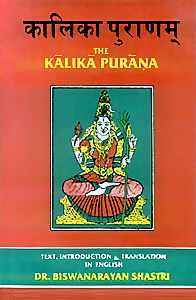 Kalika Purana is a great work which was composed in the tenth century in Assam. This Purana contains about nine thousand stanzas and ninety-eight chapters. This Purana is the only work which is dedicated to the goddess Kali, wife of lord Shiva. This is one of the rare Hindu texts that mention the word Hindu.
Kalika Purana is a great work which was composed in the tenth century in Assam. This Purana contains about nine thousand stanzas and ninety-eight chapters. This Purana is the only work which is dedicated to the goddess Kali, wife of lord Shiva. This is one of the rare Hindu texts that mention the word Hindu.
As the name suggests Kalika Purana portrays the various forms of goddess Parvati or Durga or Kali. The different manifolds of Devi Durga are Girija, Devi, Bhadrakali, Kali and Mahamya. Kalika Purana belongs to the Sakta modification of Hindu belief, or the worship of the female powers of the deities. The power of this worship is described clearly in the very first pages of the work. It relates the incestuous passion of Brahma for his daughter Sandhya, in a strain that has nothing analogous to it in the Vayu, Linga, or Shiva Puranas.
Kalika Purana contains events and conditions from the remote past. The marriage of Shiva and Parvati is described, with the sacrifice of Daksha, and the death of Sati. The Purana clearly portrays Shiva`s carrying the dead body of Parvati about the world and the body parts scattered all over the earth. The places where the body parts of the Devi fell, originated hundred and eight Pithasthanas.
This fable follows of the births of Bhairava and Vetala. Their devotion to different forms of Devi furnishes occasion to describe in great detail the rites and formula of which her worship consists.
This article is a stub. You can enrich by adding more information to it. Send your Write Up to content@indianetzone.com




















